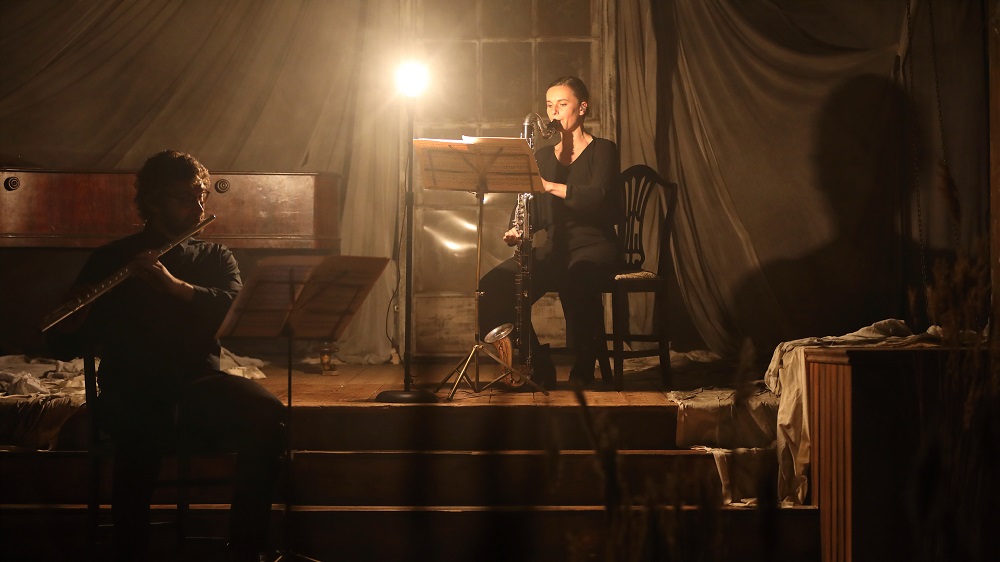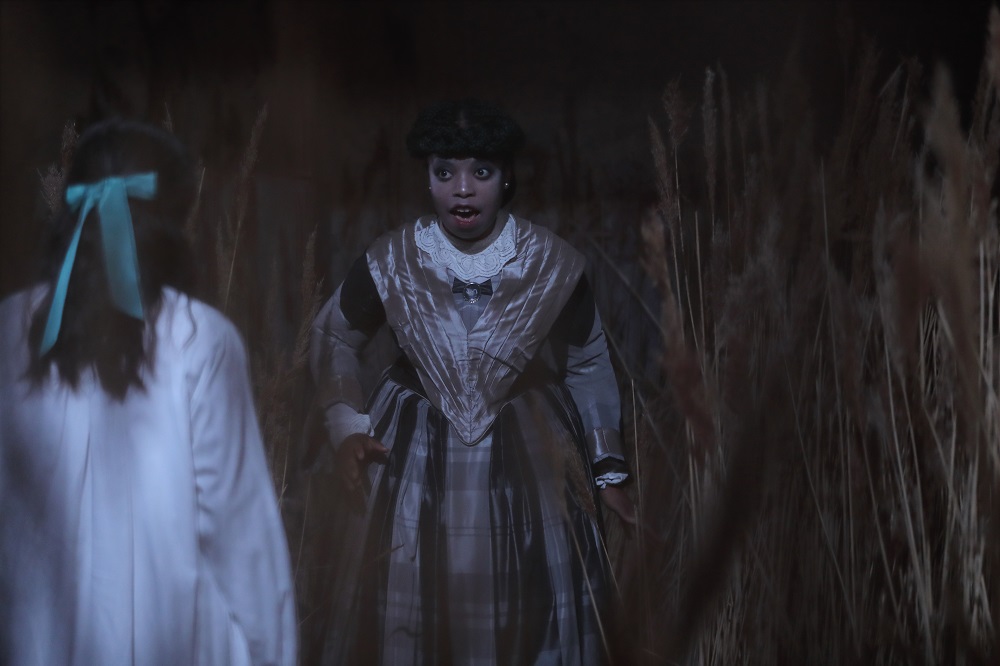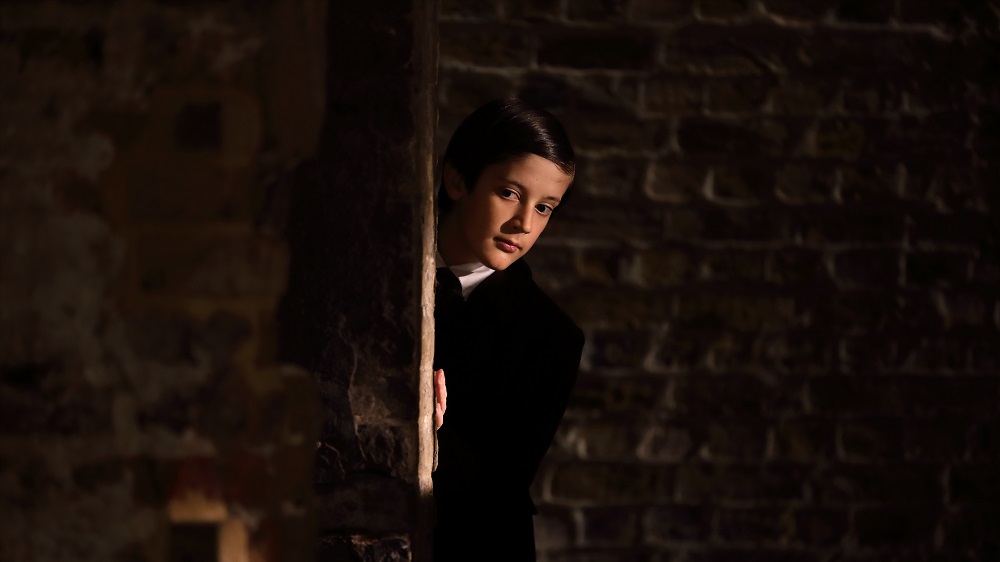It’s second time lucky for OperaGlass Works, whose previous production at Wilton’s Music Hall, of Stravinsky’s The Rake's Progress, hit the mark for me in the singing but not the staging. I suspect that had we been there in the auditorium with performers all too palpable, the same might have been true of The Turn of the Screw in this venue. But Britten’s tricky adaptation with Myfanwy Piper of the ambiguous, first-person-narrated Henry James ghost story, a musical masterpiece, works best here when the camerawork allows distance on the ghosts of the former valet and governess who haunt Bly House – or do they, other than in the mind of the present governess? – and circle for the orphaned children in her charge.
The visual success, then, is almost entirely down to Dominic Best’s filming. The two levels here, parallel to those in James’s novella which come under threat in the opera when the ghosts speak, or sing, albeit in elusive language of enticement and corruption, are the “curious story” told by stage directors Selina Cadell and Eliza Thompson, too straightforward and under-nuanced until an ending that for me makes no sense, and the cameras exploring all areas of Wilton’s, focusing on cobwebby decay and dark corners, moving up and down sinister stairs.  It’s not only the grand piano on the stage proper which stays spookily unoccupied as Robert Murray’s Prologue narrator enters the building for his accompanied recitative (superbly articulate); the music stands remain without players sitting in front of them until little by little we see (uncredited) members of the Sinfonia of London: the four woodwind "birds" that frame the governess’s short-lived summer idyll in the grounds of Bly (reedbeds where the stalls would be), later two of them taking up the creepy alto flute and bass clarinet for the troubling bedroom scene in Act Two (pictured above), a lone cellist, a pair of violinists. These are ghosts more half-glimpsed than the characters of Quint and Miss Jessel, while Best makes a virtue of conductor John Wilson only ever seen on screen – the full instrumental ensemble was recorded in Cadogan Hall – later to be superseded by the male ghost.
It’s not only the grand piano on the stage proper which stays spookily unoccupied as Robert Murray’s Prologue narrator enters the building for his accompanied recitative (superbly articulate); the music stands remain without players sitting in front of them until little by little we see (uncredited) members of the Sinfonia of London: the four woodwind "birds" that frame the governess’s short-lived summer idyll in the grounds of Bly (reedbeds where the stalls would be), later two of them taking up the creepy alto flute and bass clarinet for the troubling bedroom scene in Act Two (pictured above), a lone cellist, a pair of violinists. These are ghosts more half-glimpsed than the characters of Quint and Miss Jessel, while Best makes a virtue of conductor John Wilson only ever seen on screen – the full instrumental ensemble was recorded in Cadogan Hall – later to be superseded by the male ghost.
I could have done without the alienation technique of occasionally letting us see the camera crew and sound technicians at work; even the fierce fugal interlude which prefaces the schoolroom scene needs to stay within the realms of the claustrophobic drama, and I’m not sure about the implied spooking of this production team in Act Two. But the interludes are mostly well handled – black slides across the screen at the end of each tableau, and the title of the next is cleverly projected in different parts of the set.  All six singers are first-rate. Rhian Lois’s Governess, with her pretty youthfulness and pristine light lyric soprano, looks at first as if butter wouldn’t melt; but fuller and more threatening stops are progressively pulled out, starting with her fierce brushing-aside of the girl Flora in favour of the boy Miles during the schoolroom lesson. If they only come in fits and starts during Act Two, that’s down to the one-dimensional stage direction. Cadell and Thompson never give us the possibility that the ghosts may be purely conjured up by the young woman. By then, at least, the camerawork keeps Murray’s red-haired horror and Francesca Chiejina’s wanly insistent Miss Jessel (pictured above with Alys Mererid Robers) more often at a distance; it’s a mistake, I think, to see their standard white-faced make-up earlier.
All six singers are first-rate. Rhian Lois’s Governess, with her pretty youthfulness and pristine light lyric soprano, looks at first as if butter wouldn’t melt; but fuller and more threatening stops are progressively pulled out, starting with her fierce brushing-aside of the girl Flora in favour of the boy Miles during the schoolroom lesson. If they only come in fits and starts during Act Two, that’s down to the one-dimensional stage direction. Cadell and Thompson never give us the possibility that the ghosts may be purely conjured up by the young woman. By then, at least, the camerawork keeps Murray’s red-haired horror and Francesca Chiejina’s wanly insistent Miss Jessel (pictured above with Alys Mererid Robers) more often at a distance; it’s a mistake, I think, to see their standard white-faced make-up earlier.
Gweneth Ann Rand‘s housekeeper isn’t allowed the nuance that can make her a more insidious participant, but then perhaps that isn’t in the libretto; her wide-eyed perplexity is alarming in itself and her narrative of Bly’s dark recent past duly chills. As usual, Flora is the older rather than the younger of the siblings, and allowed more rein to freak us out in Alys Mererid Roberts’ vivid characterisation than the less easy-to-read fixity of Leo Jemison’s Miles (pictured below). His direct-to-camera looks, though, are as impressive as Lois’s, and his treble has piercing sadness in it.  Full marks for an absence of dry ice; camera filters and angles work in conjunction with Tom Piper’s set and Lewis Hannaby’s lighting to make the turns of the screw increasingly queasy. And the playing under Wilson is absolutely brilliant, with special focus on Britten’s unique writing for harp. But then the composer gives each and every one of his instrumentalists the most extraordinary solos. All deserve to be named at the end (they're not, and I'm told the names can't be divulged, reason not given), not least because I suspect many viewers won’t have realised that all that sound and sometimes fury is conjured from a mere 13 players. Praise be to the funding of this project for giving them, and the singers, a rare chance to shine in the darkest of times.
Full marks for an absence of dry ice; camera filters and angles work in conjunction with Tom Piper’s set and Lewis Hannaby’s lighting to make the turns of the screw increasingly queasy. And the playing under Wilson is absolutely brilliant, with special focus on Britten’s unique writing for harp. But then the composer gives each and every one of his instrumentalists the most extraordinary solos. All deserve to be named at the end (they're not, and I'm told the names can't be divulged, reason not given), not least because I suspect many viewers won’t have realised that all that sound and sometimes fury is conjured from a mere 13 players. Praise be to the funding of this project for giving them, and the singers, a rare chance to shine in the darkest of times.















Add comment